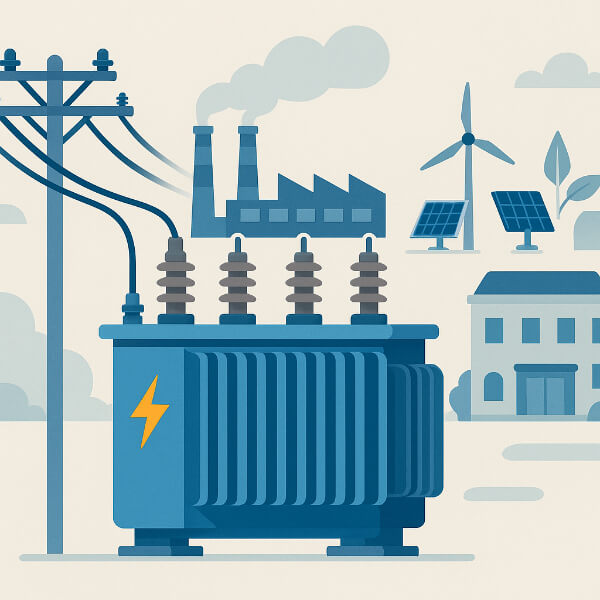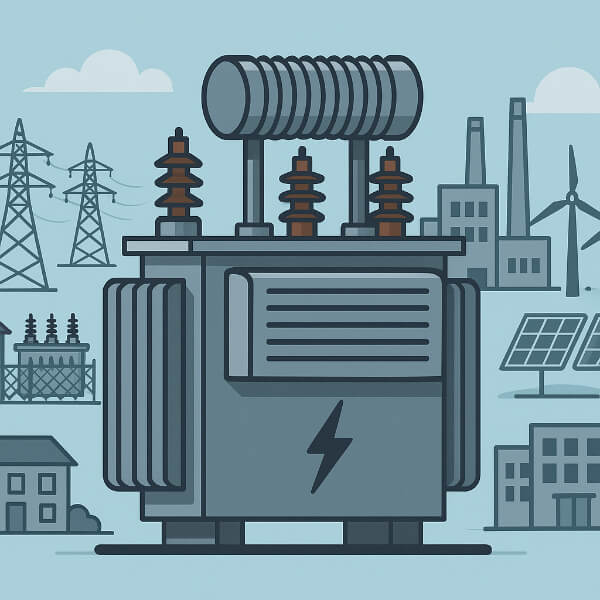Hot Keywords:
- All
- Product Name
- Product Keyword
- Product Model
- Product Summary
- Product Description
- Multi Field Search
Views: 0 Author: Site Editor Publish Time: 2025-10-28 Origin: Site









What “below 35 kV” means
When we talk about transformers below 35 kV we’re generally describing medium-voltage (MV) distribution equipment (commonly 6 kV, 10 kV, 20 kV and 35 kV) and the associated low-voltage (LV) step-downs (typically 0.4 kV / 380-415 V / 220-240 V). These units are not built for long-distance, ultra-high capacity transmission — instead they’re optimized for the “last few kilometres” of the electrical network: the streets, industrial parks, campuses and buildings that use electricity every day.
10 kV distribution transformers are the most widely used across urban and rural grids worldwide. Use cases:
Residential neighbourhoods: pad-mounted or kiosk substations and pole-mounted transformers that feed multiple apartment blocks or rows of houses.
Commercial buildings: shopping malls, hotels, hospitals and office towers where a centralized 10 kV → 0.4 kV transformer supplies lighting, HVAC, lifts and power outlets.
Municipal infrastructure: street lighting, water pumping stations, traffic control equipment, EV charging clusters.
Small and medium enterprises: general manufacturing, workshops and laundries that require three-phase low-voltage supplies.
Why 10 kV? It balances manageable line lengths, acceptable voltage regulation and modest equipment cost — ideal for most city and regional distribution tasks.

6 kV systems remain common in older heavy-industry sites. Typical uses:
Steel, mining and chemical plants with large motors and legacy drives.
Refurbishment or expansion projects where upgrading to 10 kV would be costly or require replacing many motors/equipment.
Local captive networks in industrial estates that started historically at 6 kV.
6 kV is often retained for compatibility where motor ratings and plant infrastructure make repowering impractical.
These higher MV levels are chosen when supply areas are large or loads concentrated:
Large residential developments and master-planned communities where a 10 kV network would suffer from long feeders and voltage drop.
Industrial parks and factories with aggregated loads in the megawatt range that benefit from fewer, higher-capacity feeders.
Dedicated plant substations: factories, data centres or hospitals that take a single 20/35 kV feed into an on-site substation and then distribute internally.
Medium-sized renewable plants: smaller solar or wind farms sometimes aggregate generation to 20–35 kV before interconnection.
Using 20 kV or 35 kV reduces conductor size and losses for long feeders and simplifies substation siting for large-area service.

Load matching: Most consumer equipment operates at low voltage; MV transformers provide the necessary step-down close to the point of use.
Cost-effectiveness: MV/LV equipment and cables for <35 kV are less expensive and easier to install than high-voltage alternatives.
Manageable maintenance and safety: Fewer technical and land requirements than high-voltage substations; many units are suitable for enclosed or urban installations.
Appropriate supply radius: 10 kV lines typically serve distances of a few kilometres without unacceptable voltage drop; 20–35 kV extend that radius economically.
Very long, high-capacity interregional transmission (use 110 kV and above).
Bulk power transfer between major substations or across regions — those require transmission level equipment.
Ultra-high load centres (hundreds of MVA) where stepping directly down from higher transmission voltages is more economical.
Load profile and diversity: peak kW/kVA, motor startup currents, harmonic content (inverter duty if PV/BESS/large drives present).
Voltage levels and tap range: ensure the transformer's HV tap accommodates local feeder voltage tolerances (± taps or OLTC if needed).
Cooling method and duty: ONAN/ONAF choices for continuous heavy loads or variable demand.
Protection & accessories: Buchholz, pressure relief, temperature monitoring and relays appropriate to outdoor/indoor use.
Noise, footprint and mounting: pole, pad, kiosk or indoor dry-type options depending on urban constraints.
Standards & testing: compliance with relevant national or IEC/IEEE standards and factory/site testing requirements.
Environmental constraints: oil containment, fire rating and IP enclosures for sensitive sites.
Pole-mounted oil-immersed transformers: common in rural distribution; compact and cost-effective but require maintenance access and safe clearances.
Pad-mounted (ground) transformers and kiosk substations: widely used in urban residential/commercial networks for aesthetics and secure access.
Indoor dry-type transformers: preferred where oil is prohibited (tunnels, basements, schools, hospitals).
On-site substations (20/35 kV): usually within industrial parks or campuses with fenced compound and dedicated protection.
A suburban housing estate: multiple 10 kV feeders feed banked pad-mounted 10kV/0.4kV transformers located at block corners — short cable runs, low losses, easy access.
A mid-sized factory cluster: single 20 kV incoming line to a centralized substation, step-down to 10 kV/0.4 kV distribution inside the campus — reduces number of feeders and improves power quality.
Legacy steel plant: existing 6 kV motors retained; refurbishment uses 6 kV/0.4 kV transformers to avoid costly motor replacements.
Transformers below 35 kV are engineering solutions tuned for proximity, economy and user compatibility. When you match voltage level to load density, geographic spread and equipment constraints, you optimize capital cost, energy losses and operational simplicity. For most residential, commercial and many industrial sites, these transformers are the efficient, safe and practical choice that delivers power where people and machines actually use it.